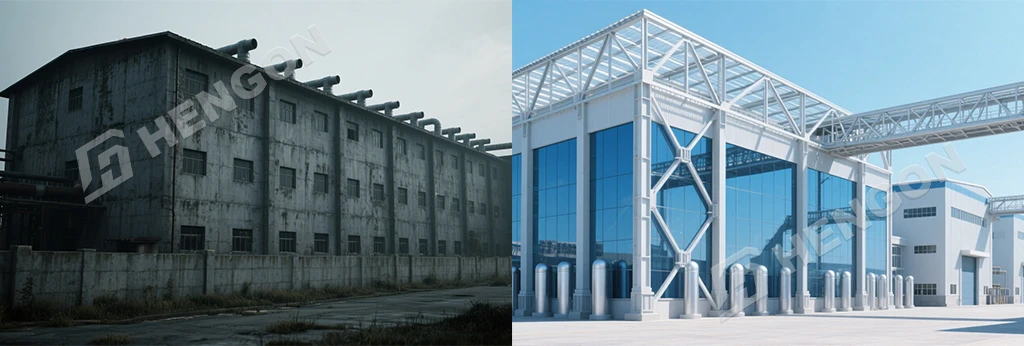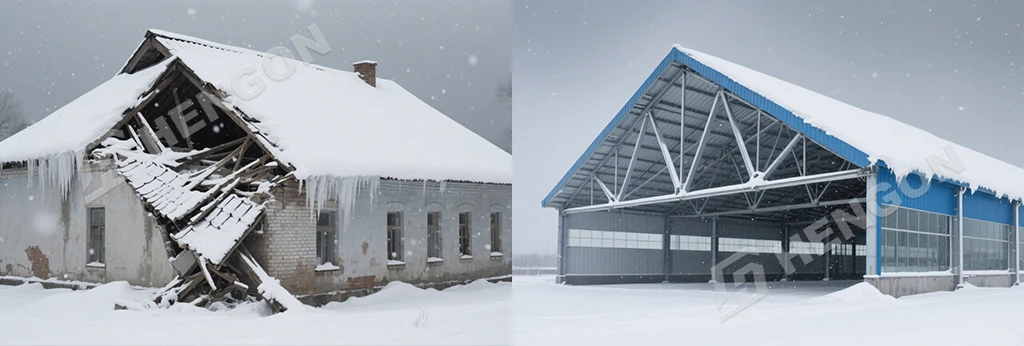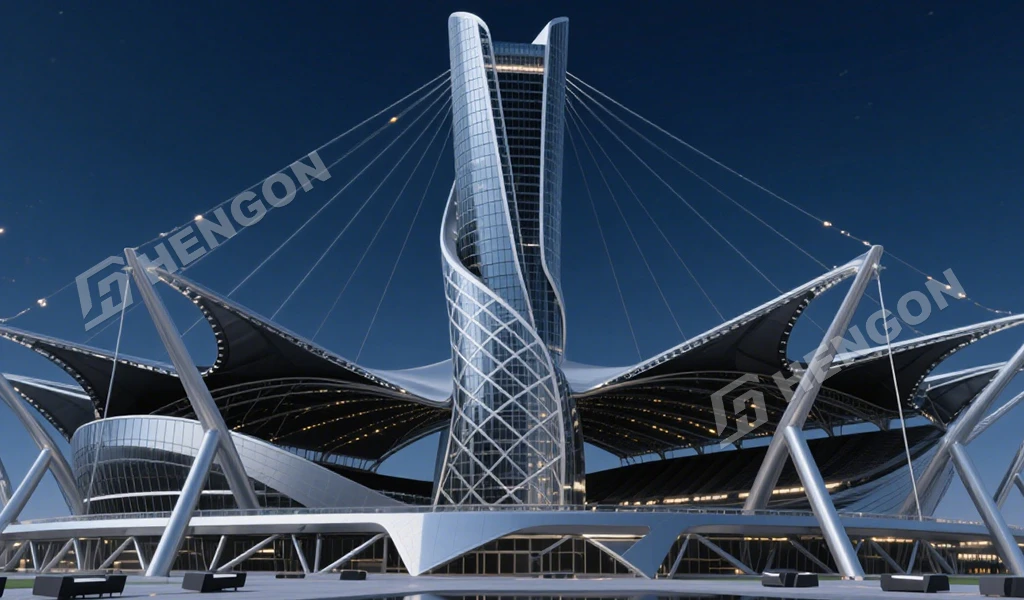
Introduction
In today’s fast-paced construction industry, clients—whether they’re building industrial warehouses, agricultural facilities, or commercial centers—have moved beyond basic expectations. Slow timelines that delay business launch, unpredictable cost hikes, and rigid designs that can’t adapt to future needs no longer cut it. What they need now is efficiency that gets projects off the ground fast, durability that stands the test of time, and sustainability that aligns with global goals. This is exactly where Steel Structure Buildings pull ahead of Traditional Architecture. Around the world, pre-engineered metal building solutions are becoming the go-to choice, proving their value in everything from small workshops to large-scale logistics hubs.
This article breaks down the key differences between Traditional Architecture and Steel Structure Buildings, highlighting why pre-engineered metal building systems are reshaping how we build in the modern era.
1. Understanding Traditional Architecture vs. Steel Structure Buildings
Traditional Architecture has relied on bricks, wood, and reinforced concrete for centuries—and while these materials have a long history, they come with unavoidable drawbacks. Construction often means weeks of on-site mixing concrete, laying bricks one by one, or cutting and fitting wood, leading to longer project cycles. Labor costs pile up because so much work has to be done manually on-site, and if you later need to expand (like adding more space to a factory), it’s often a costly, disruptive process that requires tearing down and rebuilding parts of the structure.
Steel Structure Buildings, by contrast, operate on a completely different model. Most components are precision-made as pre-engineered metal building parts in a factory—where conditions are controlled, quality is consistent, and waste is minimized. When these parts arrive on-site, they’re ready to assemble quickly, cutting down on messy, time-consuming on-site work. There’s no guesswork about whether pieces will fit, and the entire process is far more predictable.
In short: Traditional Architecture is proven but slow, costly, and inflexible. Steel Structure Buildings are efficient, adaptable, and built for the speed and demands of modern construction.
2. Cost & Pricing Advantages
Cost is always top of mind for construction clients—and here, Steel Structure Buildings have a clear edge over Traditional Architecture.
For Traditional Architecture, the math adds up quickly: more manual labor means higher labor costs, longer timelines mean paying for on-site teams longer, and materials like cement and wood have volatile prices that can spike mid-project, throwing budgets off track. Over the long term, maintenance costs also rise—wood needs treatment to fight termites, concrete can crack and require patching, and bricks are prone to moisture damage.
For Steel Structure Buildings, the savings start with pre-engineered metal building manufacturing: since 70-80% of the work happens in a factory, labor costs drop by up to 30%-50% compared to on-site building. The pricing of steel is also far more stable and transparent than cement or wood—you can lock in costs upfront, avoiding last-minute budget surprises. And when it comes to maintenance? Steel resists termites, doesn’t crack from temperature changes, and holds up against rust with simple coatings—cutting long-term upkeep expenses by half or more. All this adds up to a stronger return on investment (ROI) for clients, whether they’re building a warehouse or an agricultural facility.
3. Speed of Construction
In construction, time really is money—and Steel Structure Buildings leave Traditional Architecture in the dust here.
Traditional Architecture often means waiting months (or even years) to finish a project. Weather delays—like rain stopping concrete work or high winds halting bricklaying—are common. Coordinating suppliers for materials like wood or cement can also cause hold-ups, and every on-site mistake (like a mis-cut beam or uneven concrete) means redoing work, which eats into time. For businesses waiting to start operations—say, a farm needing a poultry barn or a company needing a warehouse—these delays translate to lost revenue.
Steel Structure Buildings fix this with the metal building general system: all parts are pre-cut, pre-drilled, and pre-assembled in the factory, so when they arrive on-site, the team just needs to bolt them together. There’s no waiting for concrete to cure or wood to be treated—on-site assembly can be done in weeks, not months. For example, a 10,000-square-foot industrial warehouse using pre-engineered metal building parts can be up and running in 6-8 weeks, compared to 4-6 months with traditional methods. This speed not only cuts down on financing costs (since you’re paying less interest on construction loans) but also lets businesses start generating income faster—a game-changer for growing companies.
4. Durability & Performance
When clients invest in a building, they want it to last—and Steel Structure Buildings deliver durability that Traditional Architecture can’t match.
Traditional Architecture has its strengths: concrete is solid, and brick is sturdy. But both are vulnerable to damage. Concrete cracks over time from temperature shifts or soil movement; brick absorbs moisture, leading to mold or erosion; and wood rots or attracts pests. In areas prone to extreme weather—like high winds, earthquakes, or heavy snow—traditional buildings often need expensive reinforcements to stay standing.
Steel Structure Buildings are built to withstand the worst. Steel frames have a high load-bearing capacity, so they can handle heavy snowfall or large equipment (like cranes in a factory) without bending. They’re designed to flex slightly during earthquakes, reducing the risk of collapse, and their sleek, non-porous surface resists wind damage and moisture. What’s more, steel is 100% recyclable—so if the building is ever taken down, the materials can be repurposed, aligning with sustainability goals. This isn’t just durability—it’s future-proofing.

Whether it’s a farming facility in a rainy region or a warehouse in a seismic zone, Steel Structure Buildings hold up better, longer.
5. Flexibility & Modern Design
Modern businesses need buildings that can grow with them—and Traditional Architecture often can’t keep up.
With Traditional Architecture, expanding a building is a headache. If you want to add space to a concrete factory, you might need to break down existing walls, pour new foundations, and rewire the entire structure—costly and disruptive. Interior columns (needed to support concrete or wood roofs) also limit open space, making it hard to use the building for large-scale needs, like a logistics hub or a workshop with big machinery.
Steel Structure Buildings solve this with built-in flexibility. The pre-engineered metal building design is modular, so expanding is as simple as adding more factory-made sections—no tearing down existing parts. Steel frames also support large spans (up to 100 feet or more) without interior columns, creating wide-open spaces perfect for warehouses, farm buildings, or commercial centers. And they’re compatible with modern tech: if you want to add automation systems (like conveyor belts in a factory or climate controls in a smart farm), the steel structure can easily accommodate wiring, pipes, and equipment. Best of all, steel doesn’t limit aesthetics—you can add glass, brick, or other finishes to match your brand, combining functionality with modern style.
6. Global Adoption & Case References
Across the globe, Steel Structure Buildings are replacing Traditional Architecture in key industries—and the results speak for themselves.
In Africa, industrial companies are using pre-engineered metal building solutions to build warehouses in remote areas, where fast construction and low maintenance are critical. In Southeast Asia, commercial centers are opting for steel frames to handle heavy monsoon rains and high humidity, while keeping costs down. In the Middle East, poultry farms are choosing Steel Structure Buildings because they’re easy to expand (as flocks grow) and resist the region’s extreme heat. These projects aren’t just exceptions—they’re proof that Steel Structure Buildings work for any climate, any industry, and any scale.

Conclusion
The choice between Steel Structure Buildings and Traditional Architecture isn’t just about materials—it’s about building for the future.
Steel Structure Buildings deliver lower costs, thanks to pre-engineered metal building efficiency and stable pricing of steel. They speed up construction with the metal building general system, getting projects done in weeks instead of months. They’re more durable, standing up to extreme weather and time. And they’re flexible, growing with your business and adapting to modern needs.
Traditional Architecture has served us well, but it can’t keep up with the demands of modern construction—efficiency, sustainability, and adaptability. As clients around the world realize this, Steel Structure Buildings aren’t just an alternative—they’re the future of construction.